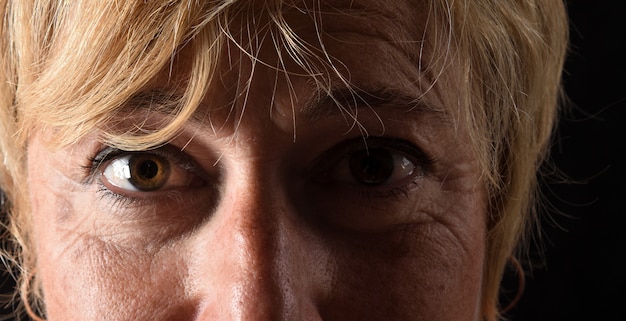Understanding Age-Related Macular Degeneration: Early Detection and Treatment Options

Understanding Age-Related Macular Degeneration: Early Detection and Treatment Options involves recognizing early signs, implementing lifestyle adjustments, and exploring potential treatments like medication, laser therapy, or surgery to slow the disease’s progression and preserve vision.
Understanding Age-Related Macular Degeneration: Early Detection and Treatment Options is crucial for maintaining vision as you age. This article explores the early signs to watch out for and the various treatment options available to help slow its progression and preserve your eyesight. Let’s delve into this important topic together, ensuring you have the knowledge to take proactive steps for your eye health.
What is Age-Related Macular Degeneration?
Age-related macular degeneration (AMD) is a prevalent eye condition that primarily affects older adults. It occurs when the macula, the central part of the retina responsible for sharp, central vision, becomes damaged. This can lead to blurred or reduced central vision, making it difficult to see objects clearly, drive, read, or recognize faces.
Understanding the basics of AMD is essential for early detection and management. Let’s explore the different types and how they impact vision.

Types of AMD
AMD is broadly categorized into two main types: dry AMD and wet AMD. Each type has distinct characteristics and progression patterns.
- Dry AMD: This is the more common form, accounting for approximately 80-90% of cases. It is characterized by the presence of drusen, which are yellow deposits under the retina. Gradual thinning of the macula also occurs.
- Wet AMD: This form is less common but more severe. It involves the growth of abnormal blood vessels under the retina, which can leak fluid and blood, leading to rapid vision loss.
Identifying which type of AMD you have is crucial, as the treatment options differ for each.
In summary, age-related macular degeneration is a condition affecting the macula, leading to central vision loss. Understanding the difference between dry and wet AMD is vital for appropriate management and treatment strategies.
Early Signs and Symptoms
Detecting AMD in its early stages is crucial for preserving vision. Many people may not realize they have AMD until it has progressed significantly. Being aware of the early signs and symptoms can lead to timely diagnosis and intervention.
Let’s examine some common indicators that may suggest the onset of AMD.
Common Symptoms to Watch For
Recognizing the symptoms early can make a significant difference in managing AMD. Here’s what to look for:
- Blurred Vision: Difficulty seeing objects clearly, especially at a distance or up close.
- Difficulty Adapting to Low Light: Needing more light than usual for reading or other tasks.
- Reduced Central Vision: Experiencing a blurry or blind spot in the center of your visual field.
- Distorted Vision: Straight lines appearing wavy or curved.
The Amsler Grid Test
The Amsler grid is a simple tool that can help you monitor your vision for signs of AMD. Here’s how to use it:
- Print out an Amsler grid (you can easily find one online).
- Tape the grid to a wall at eye level.
- Stand about 12-15 inches away from the grid.
- Cover one eye and focus on the dot in the center of the grid with the other eye.
- Repeat with the other eye.
If you notice any lines that appear wavy, broken, or distorted, it could be a sign of AMD. Consult an eye care professional immediately.
In conclusion, early detection of AMD is key to preserving vision. By being aware of the symptoms and using tools like the Amsler grid, you can take proactive steps to protect your eye health.
Risk Factors for AMD
Understanding the risk factors associated with AMD can help you assess your likelihood of developing the condition. While some risk factors are beyond your control, being aware of them can prompt you to take preventive measures and seek early detection.
Let’s delineate the primary risk factors for AMD.

Key Risk Factors Identified
Several factors can increase your risk of developing AMD. These include:
- Age: The most significant risk factor for AMD is increasing age. The condition is most common in people over the age of 60.
- Genetics: Having a family history of AMD substantially increases your risk. Genes involved in immune response and inflammation are particularly implicated.
- Smoking: Smoking is a major modifiable risk factor. It increases the risk of developing AMD and can accelerate its progression.
- Race: Caucasians are more likely to develop AMD than individuals of other races.
Knowing your risk factors can inform your approach to eye health and encourage regular check-ups.
In summary, numerous factors contribute to the risk of developing AMD. Being aware of these risks, particularly age, genetics, smoking, and race, can help you take proactive steps toward early detection and prevention.
Diagnosis of AMD
A comprehensive eye exam is critical for diagnosing AMD. These exams involve various tests and procedures to evaluate the health of your retina and macula. Early and accurate diagnosis can pave the way for timely intervention and treatment.
Let’s review the diagnostic procedures typically employed to detect AMD.
How AMD is Diagnosed
Diagnosing AMD involves a series of tests conducted by an eye care professional. These tests include:
- Dilated Eye Exam: Eye drops are used to dilate the pupils, allowing the doctor to examine the retina and macula closely.
- Optical Coherence Tomography (OCT): This imaging technique provides detailed cross-sectional images of the retina, helping to identify abnormalities such as drusen or fluid accumulation.
- Fluorescein Angiography: A dye is injected into the bloodstream, and pictures are taken of the retina to detect abnormal blood vessels, particularly in wet AMD.
Importance of Regular Eye Exams
Regular eye exams are crucial for early detection, even if you are not experiencing any symptoms. An eye care professional can identify early signs of AMD before significant vision loss occurs.
In short, the diagnosis of AMD relies on thorough eye exams, including dilated eye exams, OCT, and fluorescein angiography. Regular check-ups are essential for early detection and prompt management.
Treatment Options for Dry AMD
While there is no cure for dry AMD, several strategies can help slow its progression and manage its symptoms. Lifestyle modifications and certain supplements can play a significant role in preserving vision.
Let’s unpack the available treatment options for dry AMD.
Managing Dry AMD
The focus of managing dry AMD is to slow its progression and support overall eye health. This can be achieved through:
- Lifestyle Modifications: Quitting smoking, maintaining a healthy diet rich in fruits and vegetables, and regular exercise.
- Supplements: The Age-Related Eye Disease Study (AREDS) has shown that certain combinations of vitamins and minerals can reduce the risk of advanced AMD. These typically include vitamin C, vitamin E, lutein, zeaxanthin, zinc, and copper.
The Role of AREDS Supplements
The AREDS and AREDS2 formulas are specifically designed to provide the nutrients that have been shown to benefit people with intermediate to advanced AMD. Consult your eye care professional before starting any supplement regimen to ensure it is appropriate for you.
To summarize, managing dry AMD involves lifestyle adjustments and nutritional supplements. The AREDS formula is a key intervention to slow the progression of the disease and maintain vision health.
Treatment Options for Wet AMD
Wet AMD requires more aggressive treatment to prevent rapid vision loss. The primary goal is to stop the growth of abnormal blood vessels and reduce leakage. Several effective treatment options are available.
Let’s review the standard treatment approaches for wet AMD.
Standard Treatments Explored
The main treatments for wet AMD include:
- Anti-VEGF Injections: Drugs that block vascular endothelial growth factor (VEGF) are injected into the eye. VEGF stimulates the growth of abnormal blood vessels, so blocking it can slow or stop the progression of wet AMD.
- Laser Therapy: Photodynamic therapy (PDT) uses a laser to activate a drug that destroys abnormal blood vessels. This is less commonly used now due to the effectiveness of anti-VEGF injections.
Understanding Anti-VEGF Therapy
Anti-VEGF injections are the most common and effective treatment for wet AMD. Regular injections are needed to maintain their effect, and they can significantly reduce the risk of vision loss.
In conclusion, wet AMD requires active intervention to prevent vision loss. Anti-VEGF injections are the primary treatment, often supplemented by laser therapy in specific cases, to inhibit abnormal blood vessel growth.
| Key Point | Brief Description |
|---|---|
| 👁️ Early Signs | Blurred or distorted vision are common early indicators. |
| 🔬 Diagnosis | Comprehensive eye exams including OCT and angiography are crucial. |
| 💊 Dry AMD Treatment | Lifestyle changes and AREDS supplements can slow progression. |
| 💉 Wet AMD Treatment | Anti-VEGF injections are the primary treatment to prevent vision loss. |
Retractable FAQ Section –>
Frequently Asked Questions
Early signs of AMD include blurred vision, difficulty seeing in low light, and distortion of straight lines. Regular check-ups are essential.
There is currently no cure for AMD, but treatments are available to slow its progression and manage symptoms, especially in wet AMD.
Prevention includes quitting smoking, eating a balanced diet rich in antioxidants, and protecting your eyes from excessive sun exposure.
Yes, there are two main types: dry AMD, which progresses slowly, and wet AMD, which can cause rapid vision loss due to abnormal blood vessel growth.
The Amsler grid is a tool used to monitor changes in your central vision and detect distortions that may indicate the presence or progression of AMD.
Conclusion
Understanding Age-Related Macular Degeneration: Early Detection and Treatment Options is vital for maintaining vision health as you age. By recognizing early symptoms, being aware of risk factors, and undergoing regular eye exams, you can take proactive steps to slow the progression of AMD. Whether it’s through lifestyle adjustments, supplements, or medical treatments like anti-VEGF injections, managing AMD effectively can significantly improve your quality of life.
